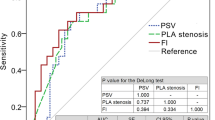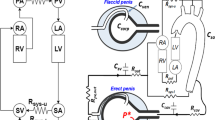Abstract
The aim of this work is to assess the value of penile duplex in the prediction of intracavernous drug-induced ischemic priapism. A total of 400 patients with erectile dysfunction were evaluated before and after diagnostic intracavernous injection of a trimix solution (papaverine+phentolamine+PGE1) using color Doppler sonography. In all, 29 patients experienced sustained rigid erections for more than an hour. Patients were further divided into two groups. Group A included patients with spontaneous resolution of their rigid erection within 3 h (10/29) and group B included patients with priapism (19/29) that did not resolve within 3 h. In group A, patients had minimal cavernous artery blood flow within the first hour postinjection, that increased with relief of their erection. Group B patients had no blood flow in their cavernous artery an hour after intracavernous injection and for 6 h later. The disappearance of blood flow in the cavernous artery after an hour of sustained rigid erection predicted priapism with 100% specificity and sensitivity. The persistent absence of cavernous artery blood flow for more than an hour, as detected by color Doppler ultrasound, is an objective predictor of priapism. This may guide early intervention to resolve the prolonged erection.
This is a preview of subscription content, access via your institution
Access options
Subscribe to this journal
Receive 8 print issues and online access
$259.00 per year
only $32.38 per issue
Buy this article
- Purchase on Springer Link
- Instant access to full article PDF
Prices may be subject to local taxes which are calculated during checkout
Similar content being viewed by others
References
Montague DK, Lakin MM . Priapism. In: Resnick MI, Novick AC (eds). Urology Secrets. Hanley-Belfus Inc.: Philadelphia, 1999, pp 267–270.
Pautler SE, Brock GB . Priapism. In: Lue TF (ed). The Urologic Clinics of North America, Erectile Dysfunction. WB Saunders: New York, pp 391–403.
Lue TF, Tanagho EA . Physiology of erection and pharmacological management of impotence. J Urol 1987; 137: 829.
Hauri D, Spycher M, Bruhlmann W . Erection and priapism: a new physiopathological concept. Urol Int 1983; 38: 138.
Meulman EJH, Diemont WL . Investigation of erectile dysfunction. Diagnostic testing for vascular factors in erectile dysfunction. Urol Clin North Am 1995; 22: 803.
Secil M et al. The prediction of papaverine induced priapism by color Doppler sonography. J Urol 2001; 165: 416–418.
Von Heyden B et al. Intracavernous pharmacotherapy for impotence: selection of appropriate patient and dose. J Urol 1993; 149: 1288.
Meulman E et al. Assessment of penile blood flow by duplex ultrasonography in 44 men with normal erectile potency in different phases of erection. J Urol 1992; 147: 51.
Author information
Authors and Affiliations
Corresponding author
Rights and permissions
About this article
Cite this article
Shamloul, R., Ghanem, H., Salem, A. et al. The value of penile duplex in the prediction of intracavernous drug-induced priapism. Int J Impot Res 16, 78–79 (2004). https://doi.org/10.1038/sj.ijir.3901152
Received:
Revised:
Accepted:
Published:
Issue Date:
DOI: https://doi.org/10.1038/sj.ijir.3901152



